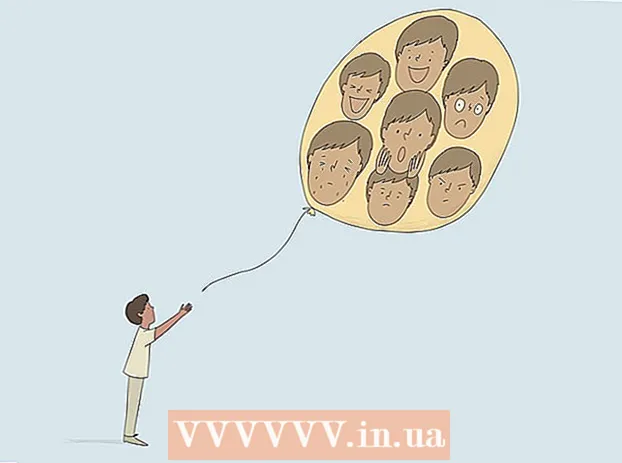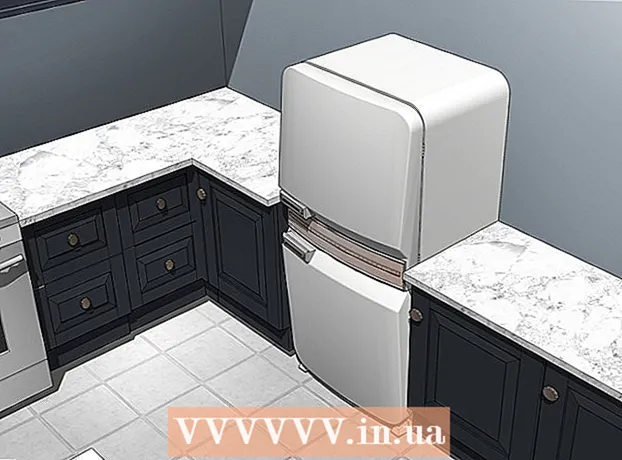Author:
Janice Evans
Date Of Creation:
3 July 2021
Update Date:
1 July 2024

Content
- Steps
- Part 1 of 3: Signs of bone fracture
- Part 2 of 3: First aid for fractured bones
- Part 3 of 3: First Aid Priorities
- Tips
- Warnings
- Similar articles
If you witness an accident in which someone is injured, call an ambulance right away if no one else can do it. This can be very difficult, especially if you are required to locate the injury under the skin. The most common injuries are a fall, car accident, or physical assault. Therefore, while waiting for qualified health workers and providing first aid to the victim, it is very important to be able to detect fractures in him in order to immediately immobilize these areas.
Steps
Part 1 of 3: Signs of bone fracture
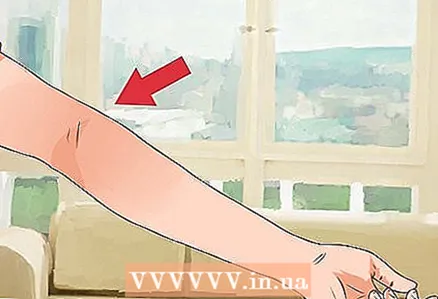 1 Check for limb dislocations or fractures. A person may have a severe open fracture in which the bone pierces the skin. However, closed fractures are more common, in which the skin over the bone remains intact. Pay attention to the victim's limbs and neck. If they are in an unnatural position or at an unnatural angle, then the person may have a fracture or dislocation. A broken or dislocated limb tends to appear shorter and may be twisted or bent in an unnatural way.
1 Check for limb dislocations or fractures. A person may have a severe open fracture in which the bone pierces the skin. However, closed fractures are more common, in which the skin over the bone remains intact. Pay attention to the victim's limbs and neck. If they are in an unnatural position or at an unnatural angle, then the person may have a fracture or dislocation. A broken or dislocated limb tends to appear shorter and may be twisted or bent in an unnatural way. - Remember not to move your neck, head, or spine if something looks unnaturally twisted or misaligned. This can lead to permanent nerve damage and deterioration of the victim's condition.
- Compare two limbs, such as the left and right legs, to notice a deformity that indicates a fracture. This makes it easier to notice something strange and unusual.
- An open fracture is much easier to notice, as the bones protrude from under the skin. These fractures are considered more serious because of the significant blood loss and the risk of infection.
- In order to thoroughly examine everything, you may need to unfasten or remove some clothes from the victim. If the person is conscious, be sure to ask their permission.
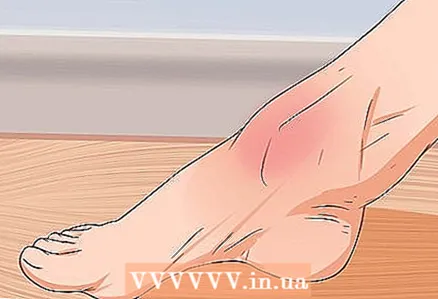 2 Pay attention to swelling and redness. A fracture is a serious injury with multiple injuries. This usually results in swelling, redness, and bruising. Inflammation and discoloration of the skin in the area of the fracture appear almost immediately, so you will probably notice them. Remove excess clothing from the victim to help you find the swelling.
2 Pay attention to swelling and redness. A fracture is a serious injury with multiple injuries. This usually results in swelling, redness, and bruising. Inflammation and discoloration of the skin in the area of the fracture appear almost immediately, so you will probably notice them. Remove excess clothing from the victim to help you find the swelling. - Edema is characterized by lumpy swelling, bloating, or swelling of tissue around the fractured bone. It is important to distinguish edema from body fat. If it is swelling, the skin above it will be dense and warm to the touch; if it is fat, then the skin will be cool.
- Swelling and discoloration are caused by damage to the blood vessels, as a result of which blood accumulates in the surrounding tissues under the skin. With fractures, the skin usually turns red, purple, and dark blue.
- With an open fracture, external bleeding occurs, which is not difficult to notice, since the blood quickly permeates most types of tissues.
 3 Try to figure out where the victim is feeling pain. As a rule, even a small crack in a bone or a bruise, and even more so a fracture, is accompanied by severe pain. However, in an emergency, it can be difficult to detect an injury from pain. First, a person can feel pain of varying intensity throughout the body. Secondly, the person may be unconscious or in a state of shock, and will not be able to answer your questions or correctly assess where the source of pain is. Ask the victim exactly where they feel pain. However, when trying to identify a fracture, do not rely solely on the person's answers.
3 Try to figure out where the victim is feeling pain. As a rule, even a small crack in a bone or a bruise, and even more so a fracture, is accompanied by severe pain. However, in an emergency, it can be difficult to detect an injury from pain. First, a person can feel pain of varying intensity throughout the body. Secondly, the person may be unconscious or in a state of shock, and will not be able to answer your questions or correctly assess where the source of pain is. Ask the victim exactly where they feel pain. However, when trying to identify a fracture, do not rely solely on the person's answers. - Feel the person's limbs and torso (especially around the ribs) carefully, and pay attention to how the victim is reacting. If a person is conscious, but unable to explain where it hurts, you can figure it out for yourself by seeing how he flinched or winced.
- If a person is unconscious, you will not be able to determine exactly where the source of pain is.
- Pain can be increased by fear or decreased by the release of adrenaline. Therefore, assessing the intensity of pain does not always help detect injury.
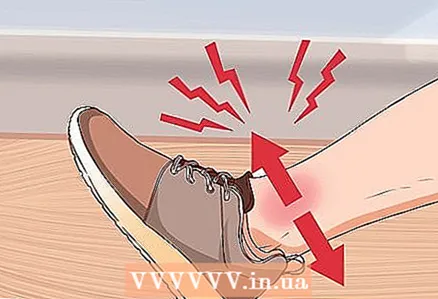 4 Find out if the victim can move their limbs. If the person is awake, ask them to slowly and gently move their shoulders, hands, legs, and feet. If it is very difficult for him to do this and when he is in pain when moving, he may have a dislocation or fracture. In addition, you may hear a grinding or crackling sound, indicating that the broken bones are rubbing against each other.
4 Find out if the victim can move their limbs. If the person is awake, ask them to slowly and gently move their shoulders, hands, legs, and feet. If it is very difficult for him to do this and when he is in pain when moving, he may have a dislocation or fracture. In addition, you may hear a grinding or crackling sound, indicating that the broken bones are rubbing against each other. - Ask him to first wiggle his toes, then bend his knees, then lift his legs off the ground, and then move his shoulders and wiggle his fingers.
- If the person moves the limbs, it can be assumed that the spinal cord is not injured. However, if the bones of the spine are damaged, any movement can lead to paralysis. Therefore, you must not move the victim until he is examined by medical professionals. An exception is the need to protect a person from further injury.
- If a person moves the limbs a little, but feels severe weakness in them, this can also indicate a dislocation, fracture, or damage to the nerves in the spine.
 5 Ask if the person feels numbness or tingling. As a rule, with a fracture, especially the large upper bones of the arms and legs, nerves are damaged, or they are stretched and irritated. This causes tingling, numbness, or a creeping sensation below the injury. Ask the victim if they have any unusual sensations in their arms and legs.
5 Ask if the person feels numbness or tingling. As a rule, with a fracture, especially the large upper bones of the arms and legs, nerves are damaged, or they are stretched and irritated. This causes tingling, numbness, or a creeping sensation below the injury. Ask the victim if they have any unusual sensations in their arms and legs. - Loss of sensation in the limbs indicates that nerves are affected. These can be the peripheral descending nerves of the arm or leg, or the spinal nerves within the spine.
- In addition to numbness and tingling, the victim may feel unusual temperature changes - a feeling of extreme cold or heat.
Part 2 of 3: First aid for fractured bones
 1 Don't move the broken bone. If you suspect that the victim has a fracture or dislocation, never move the injured bone during examination and assistance. When providing first aid, you must first of all immobilize the bone in the position that it has assumed as a result of injury or in which it is convenient for the injured person. Only those with special first aid training can reconcile a broken bone.
1 Don't move the broken bone. If you suspect that the victim has a fracture or dislocation, never move the injured bone during examination and assistance. When providing first aid, you must first of all immobilize the bone in the position that it has assumed as a result of injury or in which it is convenient for the injured person. Only those with special first aid training can reconcile a broken bone. - Do not allow the victim to move actively. A person can only slightly change his position to make him more comfortable. If he tries to get up, especially when he is in a state of shock, then this can lead to even more damage.
- You can put something under the injured part of the body to make it more comfortable for the person and so that he does not move it. To do this, use a pillow, roller, rolled-up jacket, or towel.
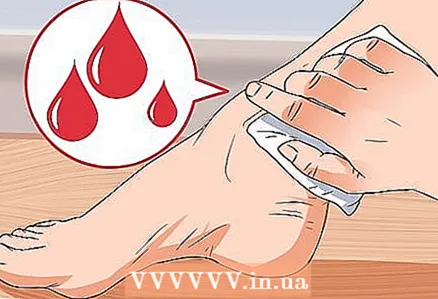 2 Stop bleeding. If there is internal bleeding with a closed fracture, there is almost nothing you can do. If the fracture is open, it is very important to try to slow down or stop the bleeding from the wound - this can save a person's life. Press down on the open wound through a sterile dressing, clean tissue, or clean clothing. Apply pressure until the blood stops and a blood clot begins to form. This can take up to five minutes or more, depending on the nature of the wound and which blood vessels are damaged.
2 Stop bleeding. If there is internal bleeding with a closed fracture, there is almost nothing you can do. If the fracture is open, it is very important to try to slow down or stop the bleeding from the wound - this can save a person's life. Press down on the open wound through a sterile dressing, clean tissue, or clean clothing. Apply pressure until the blood stops and a blood clot begins to form. This can take up to five minutes or more, depending on the nature of the wound and which blood vessels are damaged. - Wear gloves to protect yourself and the victim from blood-borne diseases. If you come into contact with human blood, you can get HIV, hepatitis, and other viral infections.
- Even if a person has a closed fracture, there may be bleeding cuts and abrasions around the fracture that need to be repaired.
- After stopping bleeding from an open fracture, cover the wound with a sterile dressing or something clean, and then secure it with a bandage. This must be done so that debris does not get into the wound and it does not become infected. Do not remove the tissue through which you applied pressure - put a new dressing on top of the old one.
- You can lightly rinse the wound with water to remove any dirt or debris. However, do not cleanse the wound too vigorously, or the bleeding may worsen.
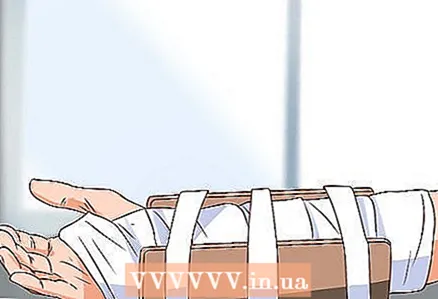 3 Immobilize the injured limb. Never try to line up a broken bone. Moreover, one should not set the protruding bone into the depth of the wound. A splint or bandage can be used to reliably immobilize the broken bone.This will be easier if you have received specialized first aid training. The splint can be made from rolled newspapers or wooden planks. Be sure to secure the splint above and below the fracture.
3 Immobilize the injured limb. Never try to line up a broken bone. Moreover, one should not set the protruding bone into the depth of the wound. A splint or bandage can be used to reliably immobilize the broken bone.This will be easier if you have received specialized first aid training. The splint can be made from rolled newspapers or wooden planks. Be sure to secure the splint above and below the fracture. - The splint can be wrapped around an arm or leg with an elastic bandage, rope, belt, strip of cloth, or some kind of clothing. Do not bandage too tightly to avoid disrupting circulation.
- Place a cloth or wide bandage under the splint to make it more comfortable for the person.
- In order to tie your hand, you can make a bandage from a regular shirt. Secure the victim's arm by tying the shirt sleeves around their neck.
- If you do not know how to apply a splint or bandage, it is best not to do it yourself. Try to stop the bleeding and wait for an ambulance to arrive.
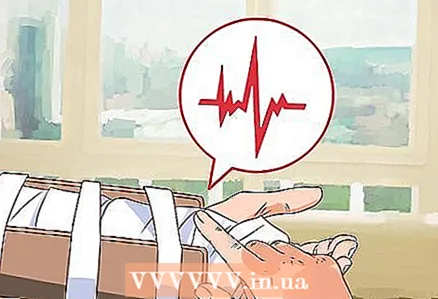 4 Monitor your circulation. If you have immobilized an arm or leg with a splint or an elastic bandage or belt, be careful not to interfere with blood circulation. Check to see if everything is in order every few minutes until an ambulance arrives. If the splint is wrapped too tightly, blood flow to the underlying tissue will be impaired. As a result, their death will occur as a result of a lack of oxygen and nutrients.
4 Monitor your circulation. If you have immobilized an arm or leg with a splint or an elastic bandage or belt, be careful not to interfere with blood circulation. Check to see if everything is in order every few minutes until an ambulance arrives. If the splint is wrapped too tightly, blood flow to the underlying tissue will be impaired. As a result, their death will occur as a result of a lack of oxygen and nutrients. - If your arm is broken, feel the pulse at your wrist, if your leg is broken, at the ankle. If a pulse cannot be felt, loosen the bandage and check again.
- You can also appreciate it visually. Press firmly on the skin below the fracture site. It should first turn pale, and then turn pink after two seconds.
- Symptoms of poor circulation are pale or bluish skin color, numbness and tingling sensations, and no pulse.
 5 Apply cold if possible. If you have ice, frozen gel packs, or bags of frozen vegetables on hand, apply them to the wound, covering it first. This will help reduce or limit inflammation and also dull pain. The ice will constrict the small blood vessels and thus the swelling will be slightly reduced. In addition, ice will help stop bleeding from an open wound.
5 Apply cold if possible. If you have ice, frozen gel packs, or bags of frozen vegetables on hand, apply them to the wound, covering it first. This will help reduce or limit inflammation and also dull pain. The ice will constrict the small blood vessels and thus the swelling will be slightly reduced. In addition, ice will help stop bleeding from an open wound. - Remember not to apply ice or anything cold directly to your skin. Be sure to wrap it in a towel, napkin, or any piece of cloth.
- Leave the ice on for 15 minutes or until an ambulance arrives.
Part 3 of 3: First Aid Priorities
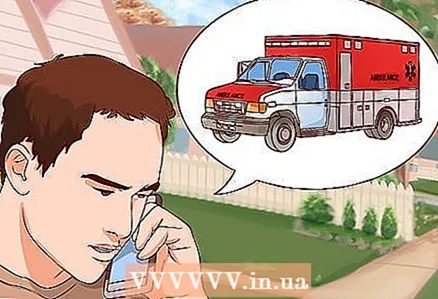 1 Call an ambulance. If you witness an accident in which someone is injured, call an ambulance right away if no one else can do it. While waiting for the arrival of an ambulance, it is important to immediately assess the injuries received and provide the victim with first aid. This should be done as soon as possible, even if you do not have special training. Lost precious minutes can cost a person his life.
1 Call an ambulance. If you witness an accident in which someone is injured, call an ambulance right away if no one else can do it. While waiting for the arrival of an ambulance, it is important to immediately assess the injuries received and provide the victim with first aid. This should be done as soon as possible, even if you do not have special training. Lost precious minutes can cost a person his life. - Call an ambulance even if the injury seems minor. This must be done, since on your own you will not be able to accurately assess the condition of a person due to the lack of training or the necessary medical equipment.
- You are not required to provide qualified medical care. Your task is to provide the victim with basic emergency care - to support the person, stop severe bleeding, try to prevent shock (see below).
 2 Inspect the scene of the incident. Before approaching the victim and giving him first aid, make sure that you are not in any danger. Electrical wires, falling debris, or an attacker can be dangerous. If you do not do this, you may be injured, and as a result, you yourself will need help.
2 Inspect the scene of the incident. Before approaching the victim and giving him first aid, make sure that you are not in any danger. Electrical wires, falling debris, or an attacker can be dangerous. If you do not do this, you may be injured, and as a result, you yourself will need help.  3 Find out if the person is breathing. After you call qualified medical attention, find out if the victim is conscious and breathing. If the person is not breathing, perform CPR first. Make sure your airway is clear before starting CPR.Do not try to find fractures until the person starts breathing and regains consciousness.
3 Find out if the person is breathing. After you call qualified medical attention, find out if the victim is conscious and breathing. If the person is not breathing, perform CPR first. Make sure your airway is clear before starting CPR.Do not try to find fractures until the person starts breathing and regains consciousness. - If you are unsure of how to properly perform CPR, use only indirect massage. If you have received special training and are confident in your abilities, give CPR, which includes artificial respiration.
- Gently lay the person on their back and kneel next to their shoulders.
- Place one hand, palm down, on the victim's sternum, between the nipples. With your other hand, cover the first and apply pressure using your entire body weight.
- Do chest compressions at about 100 per minute (try pressing to the beat of the Bee Gees '"Stayin' Alive"). Do chest compressions until an ambulance arrives. If you are tired, ask someone to replace you.
- If you have received special training, then after 30 pressures, check for airway patency and begin artificial respiration.
 4 Make sure that the person does not have shock. Calling an ambulance and making sure the person is breathing; After stopping the bleeding and immobilizing the broken bones, you must ensure that the person does not develop traumatic shock. Shock is the body's physiological response to blood loss, injury, and pain. If, in the event of a traumatic shock, timely assistance is not provided to a person, he may die. Symptoms of shock to look out for include severe weakness, rapid shallow breathing, low blood pressure, confusion, strange or inappropriate behavior, loss of consciousness.
4 Make sure that the person does not have shock. Calling an ambulance and making sure the person is breathing; After stopping the bleeding and immobilizing the broken bones, you must ensure that the person does not develop traumatic shock. Shock is the body's physiological response to blood loss, injury, and pain. If, in the event of a traumatic shock, timely assistance is not provided to a person, he may die. Symptoms of shock to look out for include severe weakness, rapid shallow breathing, low blood pressure, confusion, strange or inappropriate behavior, loss of consciousness. - Shock relief: first stop the bleeding, then position the person with their head below their torso, raise their legs, cover them with a warm blanket, and offer them something to drink if they can.
- Reassure the person by reassuring them that help is coming soon, and don't panic yourself.
- Try to convince the victim that everything will be fine with him, even if you yourself are not sure about it. Distract the person to avoid looking at their injuries.
Tips
- Sometimes injured people themselves say that they heard a click, crack, crunch or pop at the moment when the accident occurred and can explain where exactly. Inspect this area immediately.
- Even if you doubt that you have found a fracture, it is best to immobilize the area anyway.
- If the bleeding is not life threatening, do not use a tight tourniquet on the limb.
- If you suspect a person may have a spinal injury, do not move them.
Warnings
- If the bone is deformed, do not try to give it correct position... Lock her in the position she assumed as a result of the injury.
Similar articles
- How to recognize a broken thumb
- How to heal a broken toe
- How to heal broken ribs
- How to treat a broken finger
- How to treat a broken bone
- How to treat a stress fracture of the foot
- How to bandage an injured toe
- How to live with a broken wrist

